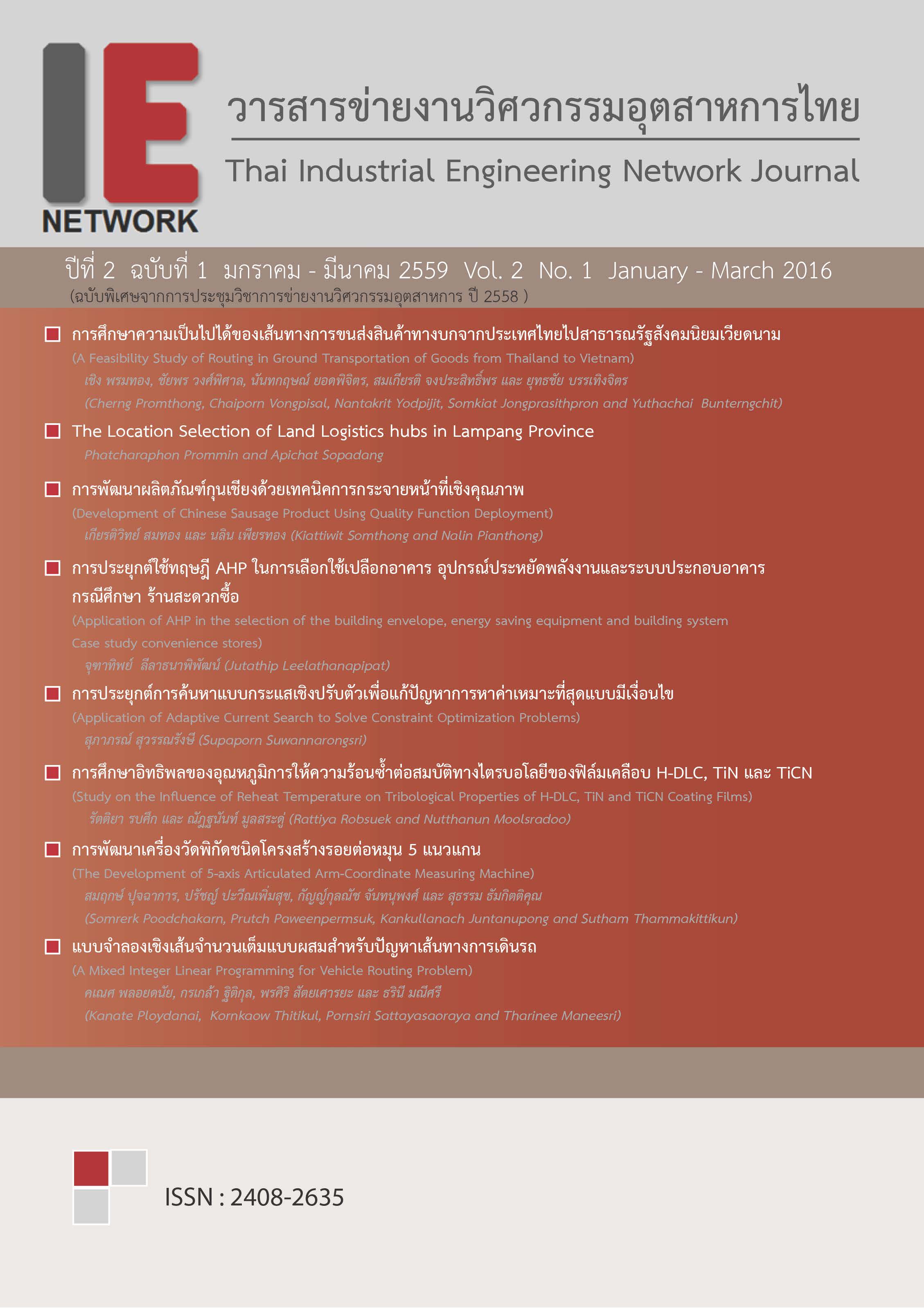The Development of 5-axis Articulated Arm-Coordinate Measuring Machine
Main Article Content
Abstract
This research presents the design and development of the Coordinate Measuring Machine (CMM) which consists of the 5 revolute joints and a spherical contact probe system. Including a signal processing - programming for computing the contact points onto a work piece in the Cartesian coordinate system. This approach used for solving the systematic errors problem of a non-directional-surface contact probe. The development probe system can be increasing the performance and precision to enumerate the contact point positions. The component of this CMM consists of 4 miniature contact switches which arranged onto perpendicularly 4 directions and on the same plane. The CMM operational principle will receive the analog signal 0-5 V. from the 5 potentiometers which each sensor has a relationship with the orientation angle of each joint. In part of the digital signal with the logic of 0, 1 from those contact switches can be detecting the 8 contact directions onto that plane. Then, collection all signal to be computed by Denavit-Hartenberg (D-H) parameters approach. These D-H equations have been proven by Mathematica commercial software. Moreover, they also proven by MSC.ADAMS the virtual motion simulation software. After that, using those correctly equations and developing with the appropriated algorithms by LabVIEW programming and processing the acquired signal from CMM. From the experimental results and calibration of this CMM with the steel-box cube of 50x50x50 mm, the average of true percent errors about 5% for every axis of the Cartesian coordinate system.
Article Details
บทความ ข้อมูล เนื้อหา รูปภาพ ฯลฯ ที่ได้รับการตีพิมพ์ในวารสารฯ ถือเป็นลิขสิทธิ์ของวารสารฯ หากบุคคลหรือหน่วยงานใดต้องการนำทั้งหมดหรือส่วนหนึ่งส่วนใดไปเผยแพร่ต่อหรือเพื่อกระทำการใดๆ จะได้รับอนุญาต แต่ห้ามนำไปใช้เพื่่อประโยชน์ทางธุรกิจ และห้ามดัดแปลง
References
เข้าถึงได้จาก: https://en.wikipedia.org/wiki/Coordinate-measuring machine
[2] Robert Bishop. LabVIEW 7 Express student edition. Prentice Hall; 2003.
[3] A.H. Slocum. Precision Machine Design. Englewood Cliffs. Prentice-Hall. NJ; 1992.
[4] Denavit Jacques Hartenberg, Richard Scheunemann. A kinematic notation for lower-pair
mechanisms based on matrices. 1955; Trans ASME J. Appl. Mech 23: 215–221.
[5] B. Maurin, O. Piccin, B. Bayle, J. Gangloff, M. de Mathelin. A parallel 5 DOF positioner for semispherical workspaces. Proceedings of the 2004 ASME Design Engineering Technical. Conferences, Salt Lake City, USA.
[6] M Ristic, I Ainsworth and D Brujic. Contact probe radius compensation using computer aided design models. 2001; Proc Instn Mech Engrs Vol 215 Part B, IMechE.
[7] N.A. Barakat, M.A. Elbestawi, A.D. Spence. Kinematic and geometric error compensation of a
coordinate measuring machine. 2000;International Journal of Machine Tools & Manufacture 40, 833–850.
[8] Z.M. Bi and S.Y.T. Lang, Joint workspace of parallel kinematic machines, Robotics and Computer-Integrated Manufacturing. 2009; 25, pp.57–63.
[9] R.K. Mittal and I.J. Nagrath, Robotics and Control. Tata McGraw-Hill Publishing Company Limited, New Delhi; 2003.
[10] P. I. Corke. June. A simple and systematic approach to assigning Denavit-Hartenberg parameters. 2007; IEEE Transactions on Robotics, vol. 23, pp. 590–594.
[11] [อินเทอร์เนต]. 2557 [เข้าถึงเมื่อ 17 มีนาคม 2557]. เข้าถึงได้จาก: https://www.mscsoftware.com/
[12] [อินเทอร์เนต]. 2557 [เข้าถึงเมื่อ 22 มีนาคม 2557]. เข้าถึงได้จาก: https://www.wolfram.com/mathematica/
[13] [อินเทอร์เนต]. 2557 [เข้าถึงเมื่อ 27 มีนาคม 2557]. เข้าถึงได้จาก: https://www.ni.com/labvie


